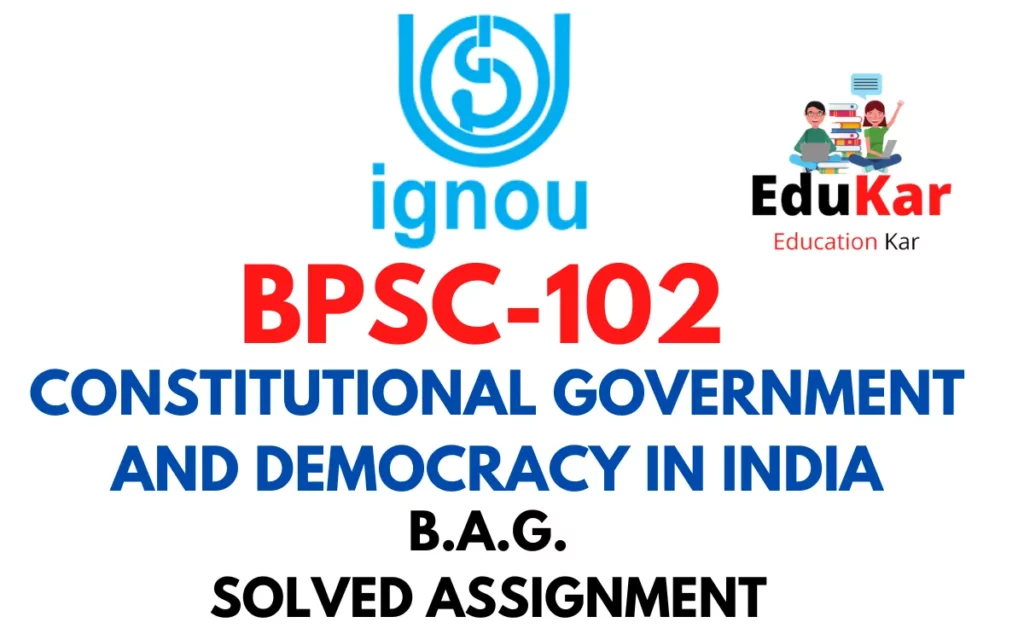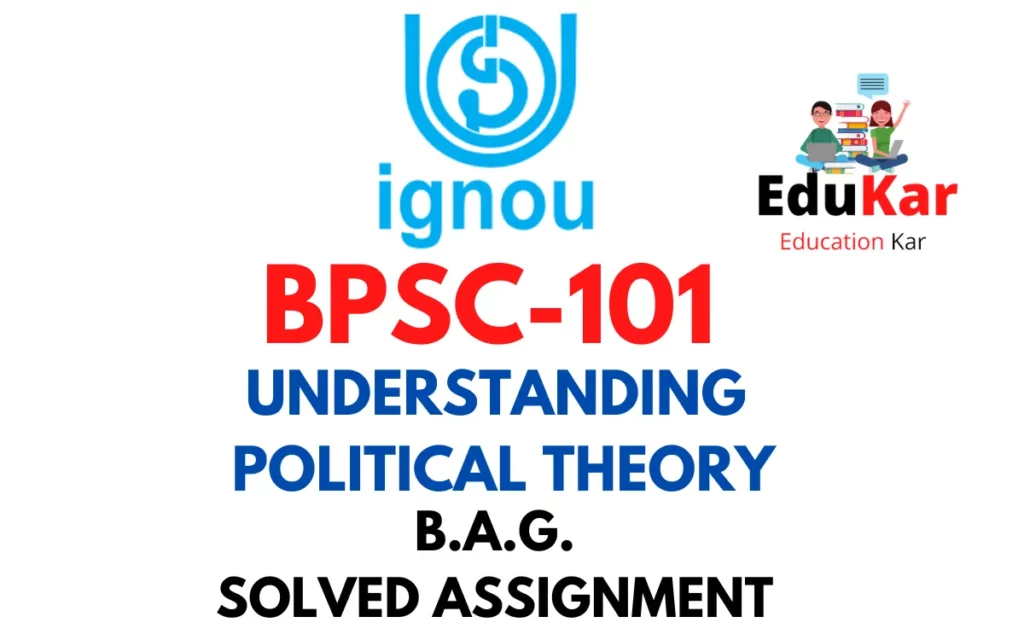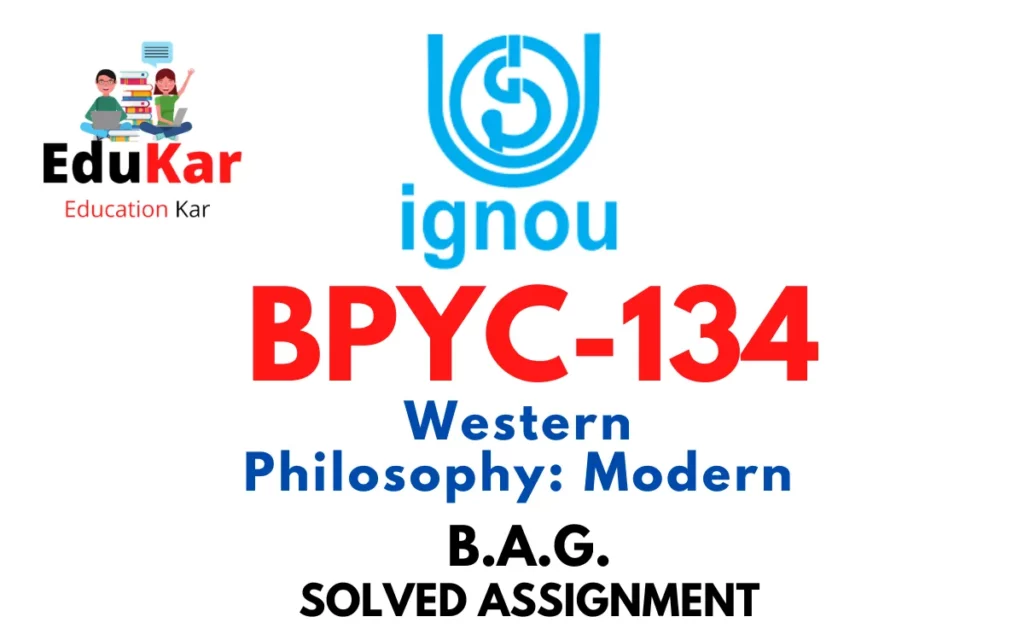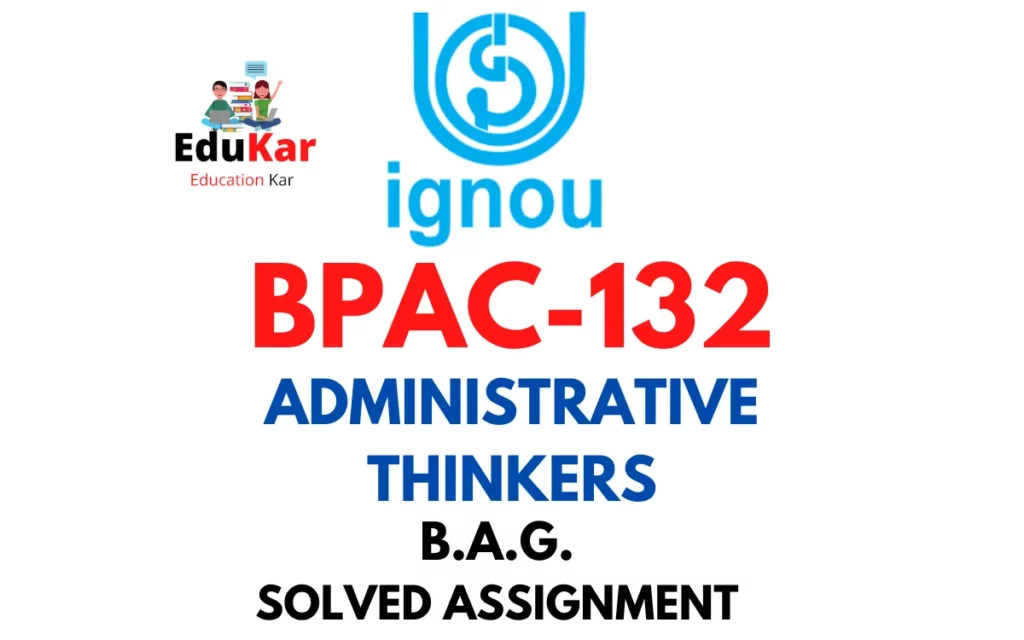Contents
- 1 Assignment – I
- 2 Answer the following in about 500 words each.
- 3 1. Elaborate upon Philosophical premises of the Indian Constitution.
- 4 2. Explain the Division of Powers between the Union and Federal Units in the Constitution of India.
- 5 Assignment – II
- 6 Answer the following questions in about 250 words each.
- 7 1. Discuss different types of emergency provisions in the Indian Constitution.
- 8 2. What were the recommendations of the Sarkaria Commission? Explain.
- 9 3. Explain the special provisions under the Fifth and Sixth Schedules of the Constitution.
- 10 Assignment – III
- 11 Answer the following questions in about 100 words each.
- 12 1. Write a brief note on Balwant Rai Mehta Committee.
- 13 2. Discuss the special powers and functions of the Rajya Sabha.
- 14 3. What are the powers of the Speaker of the Lok Sabha?
- 15 4. What is the procedure for removing a judge of the Supreme Court?
- 16 5. What are the qualifications for a member of the Indian Parliament?

| Title | BPSC-102 : IGNOU BAG Solved Assignment 2022-2023 |
| University | IGNOU |
| Degree | Bachelor Degree Programme |
| Course Code | BPSC-102 |
| Course Name | CONSTITUTIONAL GOVERNMENT AND DEMOCRACY IN INDIA |
| Programme Name | Bachelor of Arts (General) |
| Programme Code | BAG |
| Total Marks | 100 |
| Year | 2022-2023 |
| Language | English |
| Assignment Code | BPSC-102/ASST/TMA/2022-23 |
| Last Date for Submission of Assignment: | For June Examination: 31st April For December Examination: 30th September |

Assignment – I
Answer the following in about 500 words each.
1. Elaborate upon Philosophical premises of the Indian Constitution.
Ans: The Indian Constitution is grounded in several philosophical premises that reflect the values and aspirations of the people of India. These premises are derived from the ancient and medieval philosophical traditions of India, as well as from the ideas of Western thinkers such as John Locke, Montesquieu, and Rousseau. Here are some of the key philosophical premises of the Indian Constitution:
1.1. Dharma
Dharma is a central concept in Indian philosophy that refers to ethical, moral, and spiritual principles that govern the universe and human conduct. The Indian Constitution is based on the principle of dharma, which includes values such as truth, justice, equality, and respect for human rights. The Preamble to the Constitution, which is its introductory statement, declares that India is a sovereign, socialist, secular, democratic, and republic nation that is committed to securing justice, liberty, equality, and fraternity for all its citizens.
1.2. Satyagraha
Satyagraha is a nonviolent resistance movement that was developed by Mahatma Gandhi during India’s struggle for independence. The Indian Constitution draws inspiration from the philosophy of satyagraha, which is based on the principle of nonviolence and seeks to transform society through peaceful means. The Constitution guarantees the right to freedom of speech and expression, the right to peaceful assembly, and the right to form associations and unions, which are essential for the practice of satyagraha.
1.3. Ahimsa
Ahimsa is a Sanskrit word that means nonviolence or non-injury. It is a central principle in Indian philosophy and is closely linked to the idea of dharma. The Indian Constitution recognizes the importance of ahimsa and seeks to promote a culture of peace and nonviolence. The Constitution prohibits the use of force against any citizen except in accordance with law and also prohibits the use of capital punishment except in the rarest of rare cases.
1.4. Socialism
The Indian Constitution embodies the principles of socialism, which seeks to promote social justice and reduce economic inequalities. The Constitution directs the State to promote the welfare of the people, to eliminate inequality and to ensure that the ownership and control of material resources are distributed in such a way as to serve the common good. The Constitution also guarantees the right to work, the right to education, and the right to healthcare, which are essential for the realization of socialist principles.
1.5. Secularism
The Indian Constitution is based on the principle of secularism, which seeks to ensure that the State remains neutral in matters of religion and treats all religions equally. The Constitution guarantees the right to freedom of religion, the right to propagate religion, and the right to manage religious institutions, subject to public order, morality, and health. The Constitution also prohibits discrimination on the grounds of religion and ensures that no person shall be compelled to pay taxes for the promotion of any particular religion.
2. Explain the Division of Powers between the Union and Federal Units in the Constitution of India.
Ans: The Constitution of India provides for a federal system of government in which power is divided between the Union Government and the State Governments. The division of powers between the two levels of government is based on the principles of federalism, which seeks to balance the need for a strong central government with the desire for regional autonomy. Here is an explanation of the division of powers between the Union and the State Governments in India:
- Union List: The Union List contains subjects that are under the exclusive jurisdiction of the Union Government. This list includes areas such as defense, foreign affairs, currency, telecommunications, and atomic energy. The Union Government has the sole power to legislate on these matters and the State Governments cannot interfere in any way.
- State List: The State List contains subjects that are under the exclusive jurisdiction of the State Governments. This list includes areas such as public order, police, healthcare, education, and agriculture. The State Governments have the sole power to legislate on these matters and the Union Government cannot interfere in any way.
- Concurrent List: The Concurrent List contains subjects that are under the jurisdiction of both the Union and the State Governments. This list includes areas such as marriage and divorce, forests, trade unions, and electricity. Both the Union and State Governments can legislate on these matters, but in case of a conflict, the Union Law prevails.
- Residuary Powers: In addition to the three lists mentioned above, the Constitution of India also provides for residuary powers, which are not explicitly mentioned in any of the lists. These powers are vested in the Union Government and can be used in exceptional circumstances when the need arises.
- Financial Powers: The Constitution of India also provides for a system of financial powers in which the Union Government and the State Governments share revenues and expenditures. The Union Government collects taxes on subjects in the Union List and shares a portion of these revenues with the State Governments. The State Governments collect taxes on subjects in the State List and also receive a portion of the Union revenues.
Assignment – II
Answer the following questions in about 250 words each.
1. Discuss different types of emergency provisions in the Indian Constitution.
Ans: The Indian Constitution has several emergency provisions to ensure the smooth functioning of the democratic system during times of crisis. These provisions are primarily outlined in Part XVIII of the Constitution and can be classified into three types:
- National Emergency: This provision is outlined in Article 352 and can be invoked if there is a threat to the security of the nation or a part of it, whether it is due to war, external aggression, or armed rebellion. Once declared, the central government can assume more power over state governments and suspend the Fundamental Rights of citizens. However, this emergency must be approved by the President and the Parliament and is subject to judicial review.
- State Emergency: This provision is outlined in Article 356 and can be invoked when a state government is unable to function according to the Constitution. The Governor of the state must first issue a report to the President detailing the reasons for the emergency, after which the President can assume control of the state government and declare a state of emergency. This can lead to the suspension of the state government, and the President’s rule is imposed.
- Financial Emergency: This provision is outlined in Article 360 and can be invoked if there is a threat to the financial stability of India or a part of it. The central government can assume greater control over the financial affairs of the states and suspend the distribution of financial resources to them. Like other emergencies, this provision is also subject to judicial review and must be approved by both the President and the Parliament.
2. What were the recommendations of the Sarkaria Commission? Explain.
Ans: The Sarkaria Commission was a body appointed by the Indian government in 1983 to examine the relationship between the Centre and the States and suggest measures to improve it. The Commission submitted its report in 1988, which contained several recommendations. Some of the key recommendations of the Sarkaria Commission are:
- Governor Appointments: The Commission recommended that Governors should be appointed by the President after consulting with the Chief Minister of the concerned state. The Governor should have experience in public life and must be a person of standing.
- Centre-State Relations: The Commission recommended that the Centre and the States should maintain a cooperative relationship, and the Centre should provide more financial and technical assistance to the States. The Centre should also avoid interfering in the States’ affairs unless it is necessary to maintain national unity and integrity.
- Emergency Provisions: The Commission recommended that the use of emergency provisions under the Constitution, such as Article 356, should be the last resort and should only be used in exceptional circumstances.
- Legislative Powers: The Commission recommended that the legislative powers of the Centre and the States should be clearly defined to prevent conflicts between the two. It also recommended that the Centre should avoid legislating on matters that fall within the States’ jurisdiction.
- Centre-State Disputes: The Commission recommended that disputes between the Centre and the States should be resolved through peaceful means, such as negotiation and conciliation, rather than litigation.
- State Reorganisation: The Commission recommended that state reorganisation should be undertaken only after careful consideration and broad-based political consensus. The Centre should also consult with the State concerned and the concerned State Legislature before initiating the process of reorganisation.
3. Explain the special provisions under the Fifth and Sixth Schedules of the Constitution.
Ans: The Fifth and Sixth Schedules of the Indian Constitution provide for special provisions to protect the interests of certain tribal communities and areas. These provisions aim to promote the welfare of tribal communities and protect their cultural identity and land rights.
The Fifth Schedule deals with the administration and control of Scheduled Areas, which are predominantly tribal areas. The Schedule includes provisions for the establishment of a Tribal Advisory Council, which advises the Governor of the State on matters related to the administration of Scheduled Areas. The Schedule also provides for the regulation of land transfer, where the transfer of tribal land to non-tribals is restricted to prevent exploitation of tribal land and resources. The Schedule further ensures that the community’s social customs and traditions are protected while administering justice in these areas.
The Sixth Schedule deals with the administration of tribal areas in the Northeastern states of Assam, Meghalaya, Tripura, and Mizoram. The Schedule provides for the establishment of autonomous districts and regional councils, which have the power to make laws on a range of subjects, including land, forests, and local governance. These councils are also responsible for preparing plans for economic development and social justice. The Schedule further provides for the protection of the tribal community’s customary laws and practices.
The special provisions under the Fifth and Sixth Schedules recognize the unique needs and challenges faced by tribal communities and provide for their welfare and protection. These provisions help ensure that tribal communities are not left behind in India’s development process, and their rights and identity are protected. However, the implementation of these provisions remains a challenge, and efforts are needed to ensure that the benefits of these provisions reach the tribal communities effectively.
Assignment – III
Answer the following questions in about 100 words each.
1. Write a brief note on Balwant Rai Mehta Committee.
Ans: The Balwant Rai Mehta Committee was a committee set up in 1957 to examine the working of the Community Development Programme (CDP) and the National Extension Service (NES) in India. The committee was headed by Balwant Rai Mehta, a member of the Parliament of India. The committee recommended the establishment of a three-tier Panchayati Raj system in India, which would decentralize power and resources to the grassroots level. The recommendation was subsequently accepted by the government, and the 73rd Constitutional Amendment Act, 1992, was passed to give a constitutional status to the Panchayati Raj institutions in India. The Balwant Rai Mehta Committee is therefore considered a landmark in India’s efforts towards decentralization and local governance.
2. Discuss the special powers and functions of the Rajya Sabha.
Ans: The Rajya Sabha is the upper house of the Indian Parliament and has several special powers and functions that distinguish it from the Lok Sabha or the lower house. Some of the important special powers and functions of the Rajya Sabha are:
- Representation of States: The Rajya Sabha represents the states and the Union Territories of India. Its members are elected by the members of the State Legislative Assemblies in accordance with the system of proportional representation by means of the single transferable vote.
- Legislative Functions: The Rajya Sabha has the power to initiate, amend and reject bills related to any subject matter other than money bills, which can only be introduced in the Lok Sabha. The Rajya Sabha can also recommend amendments to the money bills, which the Lok Sabha may or may not accept.
- Special Powers: The Rajya Sabha has some special powers under the Constitution of India. These include the power to create new All India Services, the power to impeach the President or Vice-President of India, and the power to remove judges of the Supreme Court or High Courts.
- Constituent Assembly: The Rajya Sabha also functions as the Constituent Assembly for the Union Territories of India. It has the power to make laws for these territories and can also create or abolish legislative assemblies or councils for these territories.
- Representation in Other Bodies: Members of the Rajya Sabha are also represented in several other important bodies such as the National Development Council, the Planning Commission, and the Finance Commission.
3. What are the powers of the Speaker of the Lok Sabha?
Ans: The Speaker of the Lok Sabha is the presiding officer of the lower house of the Indian Parliament. The Speaker’s role is to conduct the proceedings of the House, maintain order, and ensure that the members of the House follow the rules and procedures laid down in the Constitution of India and the Rules of Procedure and Conduct of Business in Lok Sabha. Here are some of the powers of the Speaker of the Lok Sabha:
- Presiding over the House: The Speaker presides over the meetings of the House and maintains order during the proceedings.
- Interpretation of Rules: The Speaker has the power to interpret the rules and procedures of the House.
- Maintaining Discipline: The Speaker has the power to maintain discipline in the House, and if a member disregards the rules of the House or is guilty of any misconduct, the Speaker may order the member to withdraw from the House.
- Allotting Time for Debates: The Speaker has the power to allot time for debates and discussions in the House and can also curtail the time allotted for speeches if necessary.
- Granting Permission to Raise Issues: The Speaker has the power to grant permission to members to raise issues of public importance in the House.
- Deciding Agenda of the House: The Speaker has the power to decide the agenda of the House and determine which Bills will be taken up for discussion.
- Casting Vote: In case of a tie, the Speaker has the power to cast the deciding vote.
- Administrative Powers: The Speaker has administrative powers over the Lok Sabha Secretariat, which is responsible for the day-to-day functioning of the House.
4. What is the procedure for removing a judge of the Supreme Court?
Ans: The procedure for removing a judge of the Supreme Court of India is laid out in Article 124(4) of the Constitution of India. The process for removal involves the following steps:
- Initiation of the Motion: A removal motion against a Supreme Court judge can be initiated in either house of the Parliament by a notice signed by at least 100 members of the Lok Sabha or 50 members of the Rajya Sabha.
- Formation of an Inquiry Committee: After the notice has been given, the Speaker or the Chairman of the House will constitute an Inquiry Committee, consisting of three members – a sitting judge of the Supreme Court, a sitting Chief Justice of a High Court, and a distinguished jurist.
- Investigation and Report: The Inquiry Committee will investigate the charges made against the judge and submit its report to the Speaker or the Chairman of the House.
- Presentation of the Report: If the Inquiry Committee finds the judge guilty of any misbehavior or incapacity, the report is presented to the Parliament for further action.
- Voting: The motion for the removal of the judge is then put to vote in the House. For the motion to succeed, it needs to be passed by a special majority of two-thirds of the members present and voting in each house of Parliament.
- Presidential Approval: If the motion is passed by both houses of Parliament, it is presented to the President for his assent. After receiving the Presidential assent, the judge is removed from office.
The procedure for removing a judge of the Supreme Court is a complex and difficult process, and it is designed to ensure that judges are not removed from office without just cause. This process provides a system of checks and balances that helps to maintain the independence and integrity of the judiciary in India.
5. What are the qualifications for a member of the Indian Parliament?
Ans: To become a member of the Indian Parliament, a person must meet the following qualifications:
- Citizen of India: The person must be a citizen of India.
- Age: For the Lok Sabha (Lower House), the person must be at least 25 years old, and for the Rajya Sabha (Upper House), the person must be at least 30 years old.
- Educational Qualification: The person must have completed at least the 10th standard or equivalent.
- Disqualifications: The person must not have been convicted of any criminal offense, be of unsound mind, or hold an office of profit under the Government of India.
These qualifications ensure that the members of the Indian Parliament are qualified, competent, and representative of the diverse population of India.
How to Download BPSC-102 Solved Assignment?
You can download it from the www.edukar.in, they have a big database for all the IGNOU solved assignments.
Is the BPSC-102 Solved Assignment Free?
Yes this is absolutely free to download the solved assignment from www.edukar.in
What is the last submission date for BPSC-102 Solved Assignment?
For June Examination: 31st April, For December Examination: 30th October
















